How to Choose a Knife Sharpener
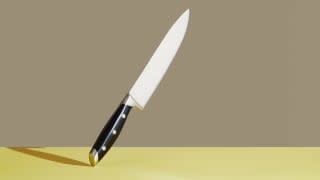
Consumer Reports has no financial relationship with advertisers on this site.
When you shop through retailer links on our site, we may earn affiliate commissions. 100% of the fees we collect are used to support our nonprofit mission. Learn more.
Your kitchen knives have been bearing the brunt of your pandemic culinary pursuits. And if you haven't given them some TLC over the past few months—or ever—you might notice that it takes some effort to chop an onion or slice a tomato.
Nope, you're not losing your touch. A dull blade is likely to blame, and it’s a downright safety risk.
“A sharp knife is a safe knife,” says Taryn Flynn, senior buyer of cutlery at the cookware retailer Williams-Sonoma. That may seem counterintuitive, but if the edge of your blade is sharp, it’s less likely to slip—potentially into a finger—as you press down to cut.
A sharp knife will also require less effort on your part, allowing easier, more fluid movements with less hand, wrist, and arm fatigue. And it allows for more precise cuts, neatly chopping herbs into ribbons instead of crushing them, for example, or effortlessly separating silverskin from muscle when trimming meat.
You can always have your knives professionally sharpened—usually less than $5 or $6 per knife. Or, if you prefer to DIY, buy a knife sharpener.
There are several basic styles to choose from. The right type for you depends on several factors, including your budget, the type of knives you already own, how frequently you use them, and your interest level in devoting time and attention to their care. The good news is that any of the available options will leave you with a sharper knife than you started with.
Here's a rundown of your choices. You can read more details on each category below.
Manual or pull-through sharpeners are lightweight and have a handle that you stabilize on the counter while you pull the knife through one or more abrasive slots, sharpening both sides of the blade at once.
Electric sharpeners use motorized, abrasive discs, wheels, or flexible belts to sharpen the knife as you gently move it through the machine. Many models have two or three levels of abrasion. The coarsest creates a new edge; one or two finer levels refine and align that edge.
Whetstones, or sharpening stones, are the traditional sharpening method and come in many styles and even more degrees of coarseness. To use one, you hold the knife horizontally to the stone, with the edge at a slight angle, as you skim it back and forth across the surface.
Honing and sharpening rods or "steels" look the same but work differently. Honing rods are usually made of steel or fine ceramic and work to align the steel fibers on the edge of the knife, improving cutting performance. Sharpening rods have a rougher surface that removes some metal from your blade, sharpening it slightly. Tapered sharpening rods are ideal for sharpening serrated blades.
How to Tell If Your Knives Need Sharpening
Chefs and cutlery experts often suggest using a tomato to determine if it's time to sharpen your knife. Bruce Aidells, chef, restaurateur, and James Beard Award-winning cookbook author, describes the simple test: "Put a tomato on a cutting board and hold the edge of your knife to the skin, putting no pressure on the knife. Then pull the knife back toward you. A sharp knife should be able to slice through the tomato on its own."
Don't have a tomato on hand? Grab a piece of paper and try to cut down through the top of the sheet. A sharp knife will slice the paper cleanly, without bending the edge down first or shredding it. If your knives don't pass the tomato or paper test, they need sharpening.
Should You Go Pro or DIY?
If you don't want another gadget in your drawer, you can have your knives sharpened professionally.
Most knife manufacturers provide sharpening services by mail for a few dollars per knife. You're responsible for shipping; ask customer service for instructions on how to pack your knives for safe shipping, or look for advice on the manufacturer's website. Or you can take your knives to a local sharpener.
But be aware that professional sharpeners have a reputation for removing too much metal at each sharpening, shortening the life of the knife. Avoid this fate by asking for a recommendation from a local knife store, fine cookware store, or your barber or hairdresser. (Hey, they rely on sharp scissors for their livelihood, Aidells points out.)
How often you need to sharpen knives depends on how you use them. Two or three times a year is often enough for most home cooks. To extend the time between sharpening sessions, use a honing rod (more on that below) to realign the edge of your knife every few times you use it.
"It's the single most important thing you can do for the longevity of your knife," says Andrew Curtis-Wellings, regional business manager for Wusthof, a knife manufacturer in Solingen, Germany.
If you go the at-home route, approach the job deliberately, no matter which type of sharpening device you choose.
Safety first: Make sure you have a clear, level workspace, and keep kids out of the room. Wear eye protection, because tiny metal fragments or abrasive particles can go flying as you work. Always keep your nondominant hand out of the path of the blade.
And read and follow all directions carefully, including the recommended angle to hold the blade, which may depend on the type of knife you own. (Most European-style knives should be sharpened at a 20-degree angle; some Japanese-style knives at 15 degrees.)
Here are the details on four types of at-home sharpening devices.
Manual or Pull-Through Sharpeners
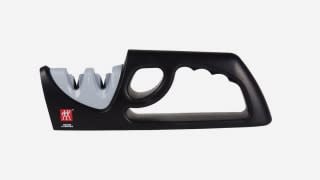
Pull-through sharpeners have a D-shaped handle on one side and one to three sharpening grooves or channels (also referred to as stages) on the other. You hold the sharpener steady on a counter while you pull your knife through each stage several times. The first groove sharpens the knife, either with a pair of abrasive wheels or an abrasive-lined v-shaped channel; additional stages use progressively finer abrasives to refine and/or hone the blade.
Who it's for: Occasional cooks who want fast and easy sharpening, or anyone looking to maintain medium-priced knives between professional sharpening sessions, says Bob Kramer, master bladesmith and founder of Kramer Knives in Bellingham, Wash.
Price: $5 to $50
Pros: They're the least expensive option and are usually quick to use, lightweight, and compact to store. Grooves or channels guide the knife, so you don't have to worry about maintaining a particular sharpening angle.
Cons: Manual sharpeners may not sharpen as well as electric models or whetstones. And they're not very effective for serrated knives.
Avoid: Inexpensive, single-stage sharpeners, which essentially just hone the knife. "If your knife is truly dull, you'll never get it sharp with a single-stage sharpener," says John Carmona, sharpening expert and founder of Sharpening Supplies.com, an online retailer.
Shop: Amazon, Bed Bath & Beyond, Target, Walmart, and Wayfair
Electric Sharpeners
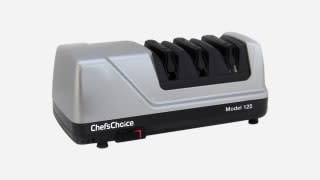
Most models have slots fitted with motorized abrasive wheels or discs that sharpen and refine both sides of a blade as you move the knife through the machine. Flexible-belt sharpeners—a newer addition to the market—use rotating abrasive belts to sharpen one side of the blade at a time; a guide helps keep your knife at the correct angle. Both types typically have at least two stages—one more abrasive stage that removes metal to shape the blade, creating the edge, and then one or two additional stages to sharpen and hone that edge.
Who it's for: Frequent cooks who prefer to sharpen their own knives without a lot of time or effort, or the cleanup involved in stone-sharpening.
Price range: $30 to $600
Pros: Electric models can sharpen even very dull knives. The slots or guides make it easy to maintain the correct angle. Belt models are customizable, Carmona says: You can choose the level of abrasion and replace the belts yourself as they wear out. Sharpening only takes a few minutes per knife.
Cons: They're more expensive than manual models, and can be bulky to store. They're noisy. If the abrasive wears out on a wheel or disk model, you’ll have to return it to the manufacturer for replacement. They don't sharpen serrated knives very well.
Avoid: Models that do not offer multiple stages. Sharpening too often or for too long could shorten the lifespan of the knife. "If you use an electric model too often—more than about three times a year—you can remove so much metal that you'll alter the original design of the knife, so it can't be used how it was manufactured to be used," says Curtis-Wellings.
Shop: Amazon, Lowe's, Walmart, and Wayfair
Whetstones or Sharpening Stones
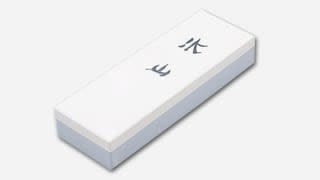
With a whetstone, "you have control over everything—over how much material gets removed, and over the shape, angle, and level of finish," Kramer says.
There are many types of sharpening stones, and you typically need two or three in varying abrasion levels—or a two- or three-sided stone. And then you'll have to learn how to use them correctly.
The basic idea is to stroke the knife back and forth across the stone's surface while holding it steady at a prescribed angle. But the motion isn't intuitive, and it isn't easy to keep that angle consistent. Taking a sharpening class at a knife store or watching instructional videos (try YouTube or your knife manufacturer's website) can help.
Even so, it's a skill that requires practice and one that even some professional cooks never master.
"I'm terrible at stone sharpening," says Jess Pryles, barbecue expert and author of "Hardcore Carnivore: Cook Meat Like You Mean It" (Agate Surrey, 2018), who relies on sharp knives for butchering meat. "So I use an electric belt sharpener at home."
Who it's for: Dedicated foodies or knife enthusiasts willing to invest the time to choose the right stone or stones and practice the correct technique. "Sitting down with your stones to tune up your knives is just another way to stay in touch with your tools and pay attention to the act of cooking," Kramer says.
Price: $30 to $300 per stone
Pros: Sharpening stones are versatile and the best way to achieve a factory-sharp edge at home. High-quality stones should last a lifetime.
Cons: Choosing the right type of stone or stones can be confusing, and there's a steep learning curve to master the correct sharpening technique, Aidells says. Sharpening itself can be time consuming—5 to 20 minutes per knife. Water stones and oil stones require soaking and/or lubricating with water or light mineral oil, and steel dust can end up all over your counter, so it's a messy job, Carmona says.
Avoid: Extremely coarse stones, which may damage your knife. "Look for a stone without inconsistencies in the grit or anomalies in the surface," Kramer says.
Shop: Amazon, Bed Bath & Beyond, Walmart, Wayfair
Honing and Sharpening Rods or 'Steels'
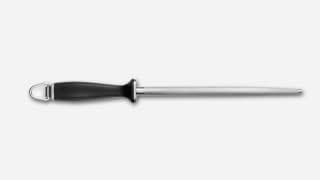
There's a lot of confusion about what to do with that rod that comes in many knife blocks, says Brendan Walsh, dean of the School of Culinary Arts at the Culinary Institute of America. But a basic honing rod (also called a steel) is an important part of knife maintenance.
Honing steels are made from ridged steel or from fine ceramic. When you run your knife's blade along the surface of a honing rod, friction helps realign the edge, straightening metal fibers that have become bent during the cutting process. (Imagine standing blades of grass back up after they've been flattened.)
There are also sharpening rods—confusingly, also known as sharpening steels, even when they're not made of steel at all, but diamond or ceramic abrasive. These—unlike honing steels—remove a small amount of metal from the blade as they sharpen it.
Who it's for: Honing rods or steels are for everyone. Honing after every few uses will help your knife perform better and can help extend the time between sharpening, Flynn says. Sharpening rods are great for tune-ups (every few weeks) between professional sharpening—or home whetstone or electric sharpening. And they're the best way to sharpen a serrated knife yourself, Carmona says.
Price: $40 to $100. One might be included in a set of knives that comes with a block.
Pros: A honing steel will help maintain the edge of your knife between sharpenings and may mean you have to sharpen less frequently.
Cons: There's a slight learning curve to master the correct use.
Avoid: Trying to sharpen with a honing steel or trying to hone with a sharpening steel.
